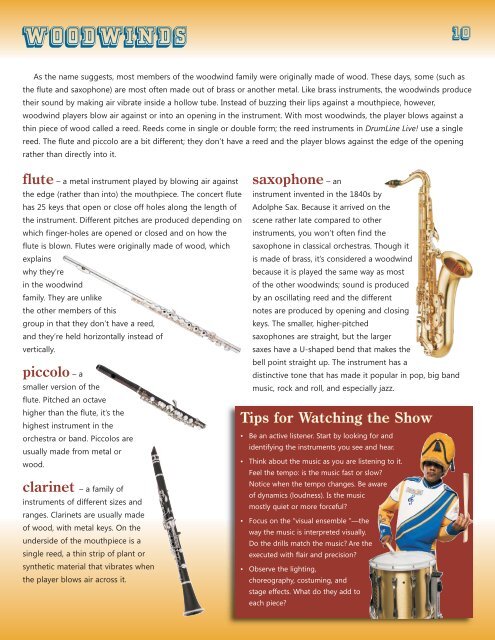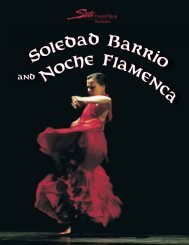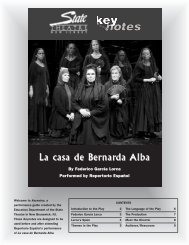Drumline 2011 Keynotes:Layout 1.qxd - State Theatre
Drumline 2011 Keynotes:Layout 1.qxd - State Theatre
Drumline 2011 Keynotes:Layout 1.qxd - State Theatre
You also want an ePaper? Increase the reach of your titles
YUMPU automatically turns print PDFs into web optimized ePapers that Google loves.
Woodwinds 10<br />
As the name suggests, most members of the woodwind family were originally made of wood. These days, some (such as<br />
the flute and saxophone) are most often made out of brass or another metal. Like brass instruments, the woodwinds produce<br />
their sound by making air vibrate inside a hollow tube. Instead of buzzing their lips against a mouthpiece, however,<br />
woodwind players blow air against or into an opening in the instrument. With most woodwinds, the player blows against a<br />
thin piece of wood called a reed. Reeds come in single or double form; the reed instruments in DrumLine Live! use a single<br />
reed. The flute and piccolo are a bit different; they don’t have a reed and the player blows against the edge of the opening<br />
rather than directly into it.<br />
flute – a metal instrument played by blowing air against<br />
the edge (rather than into) the mouthpiece. The concert flute<br />
has 25 keys that open or close off holes along the length of<br />
the instrument. Different pitches are produced depending on<br />
which finger-holes are opened or closed and on how the<br />
flute is blown. Flutes were originally made of wood, which<br />
explains<br />
why they’re<br />
in the woodwind<br />
family. They are unlike<br />
the other members of this<br />
group in that they don’t have a reed,<br />
and they’re held horizontally instead of<br />
vertically.<br />
piccolo – a<br />
smaller version of the<br />
flute. Pitched an octave<br />
higher than the flute, it’s the<br />
highest instrument in the<br />
orchestra or band. Piccolos are<br />
usually made from metal or<br />
wood.<br />
clarinet – a family of<br />
instruments of different sizes and<br />
ranges. Clarinets are usually made<br />
of wood, with metal keys. On the<br />
underside of the mouthpiece is a<br />
single reed, a thin strip of plant or<br />
synthetic material that vibrates when<br />
the player blows air across it.<br />
saxophone – an<br />
instrument invented in the 1840s by<br />
Adolphe Sax. Because it arrived on the<br />
scene rather late compared to other<br />
instruments, you won’t often find the<br />
saxophone in classical orchestras. Though it<br />
is made of brass, it’s considered a woodwind<br />
because it is played the same way as most<br />
of the other woodwinds; sound is produced<br />
by an oscillating reed and the different<br />
notes are produced by opening and closing<br />
keys. The smaller, higher-pitched<br />
saxophones are straight, but the larger<br />
saxes have a U-shaped bend that makes the<br />
bell point straight up. The instrument has a<br />
distinctive tone that has made it popular in pop, big band<br />
music, rock and roll, and especially jazz.<br />
Tips for Watching the Show<br />
• Be an active listener. Start by looking for and<br />
identifying the instruments you see and hear.<br />
• Think about the music as you are listening to it.<br />
Feel the tempo: is the music fast or slow<br />
Notice when the tempo changes. Be aware<br />
of dynamics (loudness). Is the music<br />
mostly quiet or more forceful<br />
• Focus on the “visual ensemble “—the<br />
way the music is interpreted visually.<br />
Do the drills match the music Are the<br />
executed with flair and precision<br />
• Observe the lighting,<br />
choreography, costuming, and<br />
stage effects. What do they add to<br />
each piece
















